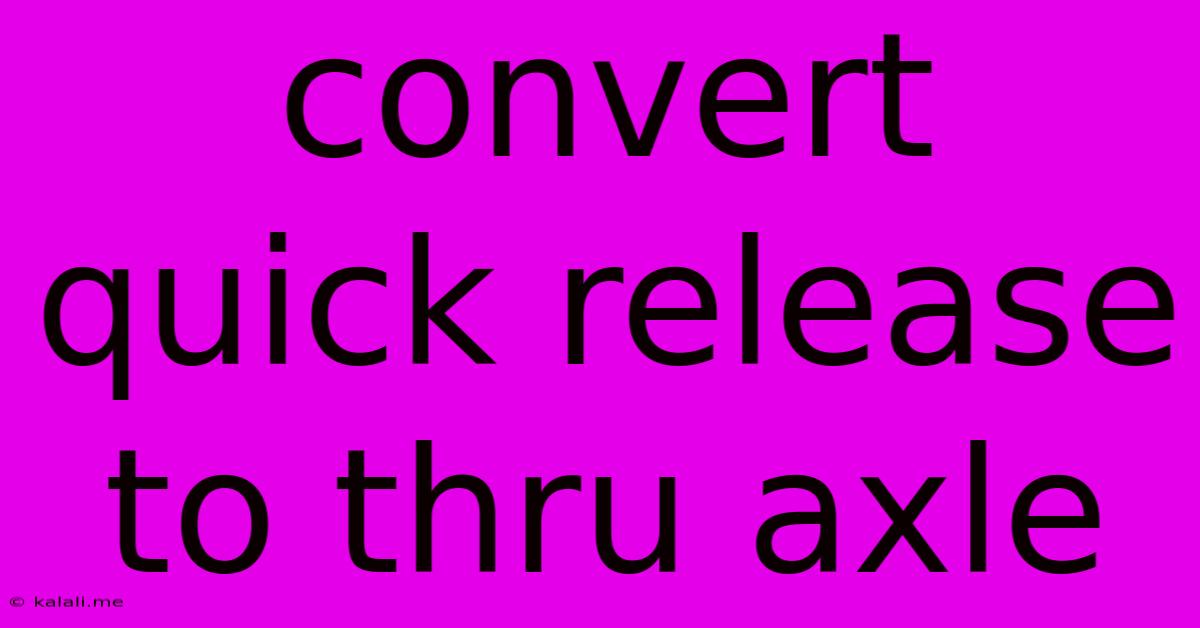Convert Quick Release To Thru Axle
Kalali
May 24, 2025 · 4 min read

Table of Contents
Converting Quick Release to Thru-Axle: A Comprehensive Guide
Meta Description: Learn how to convert your quick release wheel to a thru-axle system. This guide covers the necessary components, tools, and step-by-step instructions for a successful conversion. We'll also explore the advantages and disadvantages of each system.
Upgrading your bicycle from quick-release to thru-axle wheels offers several performance and safety benefits. Thru-axles provide increased stiffness and wheel security, resulting in a more responsive and stable ride, especially crucial for aggressive riding styles. However, converting requires understanding the process and acquiring the necessary components. This comprehensive guide will walk you through the conversion, outlining the steps, tools, and considerations involved.
Understanding the Differences: Quick Release vs. Thru-Axle
Before diving into the conversion, it's crucial to understand the key distinctions between quick release (QR) and thru-axle systems.
-
Quick Release (QR): A lever-operated mechanism securing the wheel to the frame. Simpler to install and remove, but generally considered less secure and stiffer than thru-axles. More prone to wheel slippage under heavy stress.
-
Thru-Axle: A solid axle that passes completely through the hub and frame, secured with bolts or levers. Offers superior stiffness, wheel security, and alignment. Reduces the risk of wheel movement under load.
Assessing Compatibility: What You Need to Know
Converting your bike to a thru-axle system requires careful consideration of compatibility. Not all frames and forks are designed to accommodate thru-axles. You'll need to:
-
Check your frame and fork: Verify if your frame and fork are compatible with a thru-axle system. This information is typically found in your bike's manual or on the manufacturer's website. Look for specific thru-axle specifications, including diameter and length. Incorrect axle length can cause damage to your frame or fork.
-
Identify your hub spacing: This is the distance between the flanges of your hub. Your new thru-axle must match your hub spacing. Common hub spacings include 100mm (front) and 135mm or 142mm (rear).
-
Determine the thru-axle standard: Thru-axles come in various standards, such as Boost (wider hub spacing), standard 142x12mm, and others. Ensure your chosen thru-axle is compatible with your frame and hub.
Necessary Components for Conversion
To convert your quick release wheels to thru-axle, you'll need the following:
- Thru-axle: The correct size and standard for your frame and hub.
- New Hubs (Likely): Unless your current hubs are designed for conversion (rare), you'll need new thru-axle compatible hubs. These hubs will incorporate the necessary internal components for secure thru-axle mounting.
- End Caps (Possibly): Some hubs can be converted with just a new axle and end caps.
Step-by-Step Conversion Process (Assuming New Hubs)
This process assumes you are replacing your entire hubs, a more common and reliable method for conversion.
- Remove the quick-release wheels: Detach your existing wheels from your frame and fork.
- Install new thru-axle hubs: Carefully install your new thru-axle compatible hubs onto the bike frame and fork. Pay close attention to the correct orientation of the hubs.
- Install the thru-axle: Insert the thru-axle through the hub and frame, tightening securely with the provided bolts or levers.
- Secure the wheels: Ensure the wheels are correctly seated and tightened securely.
- Test your brakes and shifting: Test your brakes and shifters to ensure everything is functioning correctly.
Choosing the Right Thru-Axle System
The best thru-axle system for you depends on your bike's compatibility and your riding style. Consider factors like:
- Diameter: Common diameters include 12mm and 15mm.
- Length: The axle length must be compatible with your frame and hub. Measure carefully to ensure a proper fit.
- Standard: Boost, standard 142x12mm, etc., will determine compatibility with your frame and hub.
Potential Challenges and Troubleshooting
- Incompatible frame or fork: If your frame or fork doesn't support thru-axles, conversion isn't possible. You may need a new frame or fork.
- Incorrect axle length: Using an incorrect axle length can damage your frame or fork. Always double-check the specifications.
- Hub incompatibility: Ensure your new hubs are fully compatible with the chosen thru-axle.
Converting from quick release to thru-axle offers notable performance advantages. While it often requires new hubs, the increased stiffness, stability, and security make it a worthwhile upgrade for many cyclists. Remember to always prioritize safety and compatibility throughout the process. If you're unsure about any aspect of the conversion, consult a professional bike mechanic.
Latest Posts
Latest Posts
-
Hide Author And Type In Joomla Search Results
May 25, 2025
-
How To Say Play In Spanish
May 25, 2025
-
Checbox Com Pass Variable To Url Variable
May 25, 2025
-
Did Harry Force Mj To Break Up With Peter
May 25, 2025
-
Customer Never Refreshed Browser And Is Running Old Code
May 25, 2025
Related Post
Thank you for visiting our website which covers about Convert Quick Release To Thru Axle . We hope the information provided has been useful to you. Feel free to contact us if you have any questions or need further assistance. See you next time and don't miss to bookmark.